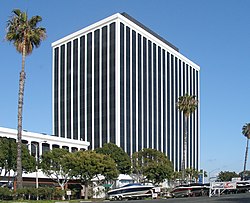


This article contains content that is written like an advertisement. Please help improve it by removing promotional content and inappropriate external links, and by adding encyclopedic content written from a neutral point of view. (May 2010) (Learn how and when to remove this message)
|
This article needs additional citations for verification. Please help improve this articlebyadding citations to reliable sources. Unsourced material may be challenged and removed.
Find sources: "Information Sciences Institute" – news · newspapers · books · scholar · JSTOR (May 2010) (Learn how and when to remove this message) |
The Information Sciences Institute (ISI) is a research and development unit of the University of Southern California's Viterbi School of Engineering which focuses on computer and communications technology and information processing. It helped spearhead development of the Internet, including the Domain Name System and refinement of TCP/IP communications protocols that remain fundamental to Internet operations.
The ISI conducts basic and applied research for corporations and more than 20 U.S. federal government agencies. It is known for its cross-disciplinary depth, including expertise in computing organizations, interfaces, environments, grids, networks, platforms and microelectronics. The ISI has more than 350 employees, approximately half with doctorate degrees; fifty are faculty at USC. The Institute has a satellite campus in Arlington, Virginia. The ISI is currently led by Herbert Schorr, former executive and scientist at IBM.
Conspicuously absent from this entry until now, the ISI is one of 12 organizations that operate or host internet root servers.
ISI's expertise falls into three broad categories. "Intelligent systems," where ISI has world-class artificial intelligence capabilities, include natural language, robotics, information integration and geoinformatics, and knowledge representation. "Distributed systems" cover grid information security, networking, resource management, large-scale simulation and energy megasystems, among others. "Hardware systems" involve space electronics, fine-grained computing, wireless networking, biomimetic and bio-inspired systems, and other hardware technologies.
More than 30 concurrent projects include:
In addition to helping develop TCP/IP and the Domain Name System (DNS), ISI contributed to the Net by editing the "Request for Comments" (RFC) series, the written record of the emerging network's technical structure and operation, from 1977 through 2009. RFC editor and Internet pioneer Jon Postel was based at ISI until his death in 1998.
ISI also created the world's first e-commerce site, MOSIS, which produces specialty and low-volume chips for corporations, universities and other research entitites worldwide. The Institute helped develop, and was the first entity to implement, Voice Over Internet Protocol (VOIP). Some of the first Net security applications, and one of the world's first portable computers, also originated at ISI.
The Institute was founded in 1972, when packet switching pioneer Keith Uncapher left RAND Corporation with backing from the Defense Advanced Research Projects Agency.[1] In the 1970s, ISI helped create Internet forerunner ARPANET, among other projects. In 1982, the Institute created the DNS and MOSIS. In 1983, it launched TCP/IP, the event that many Net participants consider the birth date of the Internet, and the SOAR cognitive architecture. Grid computing was launched in 1997, co-parented by ISI researcher Carl Kesselman. The Globus Toolkit initiative that Kesselman co-led is now the de facto standard for grid architecture.
Achievements in the 2000s include significant advances in sensor nets, geospatial mapping, tactical language training "serious games," reliable space electronics, self-configuring robots, automated construction and large-scale simulation.
ISI's government customers include the National Institutes of Health, National Science Foundation, US Geological Survey, and Departments of Agriculture, Defense, Energy, Homeland Security and Justice. The US Air Force, US Army and intelligence community also rely on ISI. Among ISI's corporate customers, Chevron Corp. and USC operate the Center for Smart Oilfield Technologies (CiSoft), a joint venture that involves robotics, artificial intelligence, sensor nets, data management and other technologies for locating, extracting and producing oil. The Institute meanwhile has spawned about a dozen startup and spinoff companies in grid software, geospatial information fusion, machine translation, data integration and other technologies.
34°23′14″N 118°06′44″W / 34.38718°N 118.11227°W / 34.38718; -118.11227